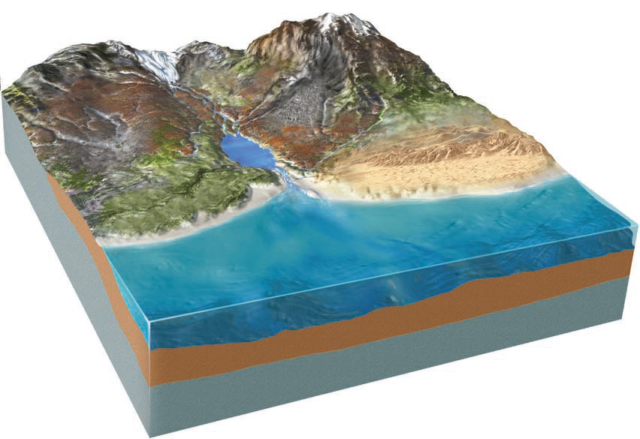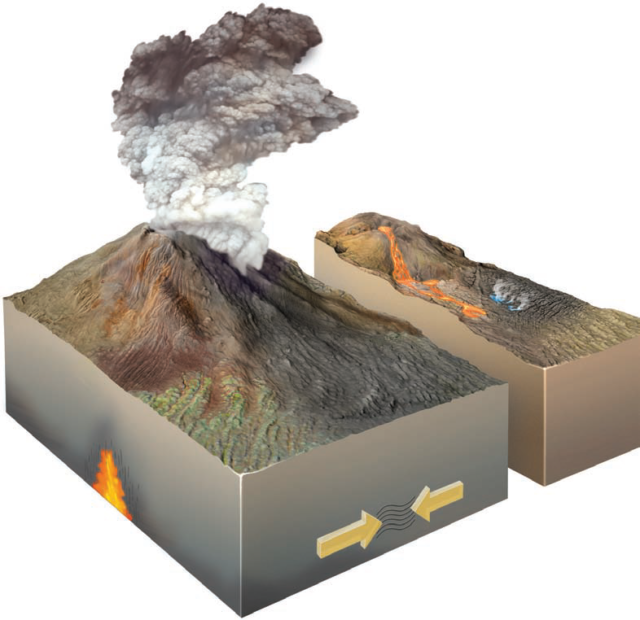How Do Rocks Form?
VARIOUS PROCESSES OPERATE on and within Earth to produce the variety of rocks we observe in landscapes. Many common rocks form in stream bottoms, beaches, or other familiar environments on Earth’s surface. Other rocks form in less familiar environments, under high pressure deep within Earth, or at high temperatures associated with a volcano. To understand the different kinds of rock that can form, we explore the types of materials that characterize different modern-day environments.
What Types of Sediments Form in Familiar Surface Environments?
Some types of rock form from the combination of loose materials that were brought together somehow in a location. Think about what you have observed on the ground in places such as lakes, streambeds, and mountainsides — probably mud, sand, and larger rocks. These loose materials are sediment and are formed by the breaking and wearing away of other rocks in the landscape. Although more hidden from us, sediment also occurs beneath the sea.
Glaciers incorporate rock debris into their flowing, icy masses. They carry a wide variety of sediment, from large, angular boulders to fine rock powder. They ultimately deposit the sediment along the edges of the melting ice.
Steep mountain fronts exhibit large, angular rocks that broke away from bedrock and moved downhill under the influence of gravity. Steep mountains may produce landslides and unstable, rocky slopes covered with angular blocks.

Stream channels contain sand and bigger pebbles and cobbles, whereas low areas beside the channel accumulate smaller particles of silt and clay, which were carried farther from the stream channel during floods. Some streams flow into lakes, which have a muddy, clayey bottom, with sand around the lake shore.
In deeper water, the seafloor consists of mud and the remains of swimming and floating creatures that settle to the bottom. Seafloor closer to the land receives a greater contribution of sand and other sediment derived from the land. Streams and wind are especially effective in delivering this sediment from the land to the sea.
Beaches typically have waves, sand, broken shells, and rounded, well-worn stones. Some beaches are mostly sand, and others are mostly stones.
Sand dunes are mostly sand, which has been shifted along the ground by wind. They contain sand because sand is too large for wind to move out of the area, and wind blows away smaller particles,
like clays.
What Types of Rocks Form in Hot or Deep Environments?
- In many volcanoes, magma flows onto the surface, creating lava that flows downhill or piles up around a vent.
- Explosive volcanoes erupt volcanic ash, which can fall back to Earth and blanket the terrain or can rapidly and dangerously surge down the flanks of a volcano.
- Magma that does not erupt may cool and solidify in a magma chamber, forming granite or other rocks at depth. Heat from the magma chamber may bake adjacent rocks, changing them into different kinds of rocks.
- Deep within Earth where temperatures and pressures are high, forces can squeeze and deform rocks into new atomic arrangements and into new types of rocks. Under such force, solid rocks slowly flow, shear, and bend. Changing a rock by heat, pressure, or deformation is the process of metamorphism.
- Distinctive rocks form when hot waters cool and grow minerals. This may occur beneath the surface or on the surface in hot springs.

Families of Rocks
The diverse environments shown on these pages produce many different types of rocks that, depending on the classification scheme, are grouped into three or four families. To interpret how rocks form, we observe modern environments and note the dominant types of sediment, lava, or other material. We infer that these same types of materials would have been produced in older, prehistoric versions of that environment. By doing this, we use modern examples to interpret ancient rocks and to understand how they formed. In this way, the present is the key to the past.
Sedimentary rocks form on Earth’s surface, mostly from loose sediment that is deposited by moving water, air, or ice. If loose sediment is buried, it can become consolidated into hard rock over time. Other types of sedimentary rocks form by growing minerals from water or by coral and other organisms that extract material directly from water. Rocks formed from cooled and solidified magma are igneous rocks. These form when volcanoes erupt ash and lava or when molten rock crystallizes in magma chambers at depth.
Rocks changed by temperatures, pressures, or deformation are metamorphic rocks. Metamorphism can change sedimentary or igneous rocks, or even further modify preexisting metamorphic rocks. Finally, some rocks grow directly from hot water, and these are commonly considered to be a type of metamorphic rock because they result from fluids at high temperatures.